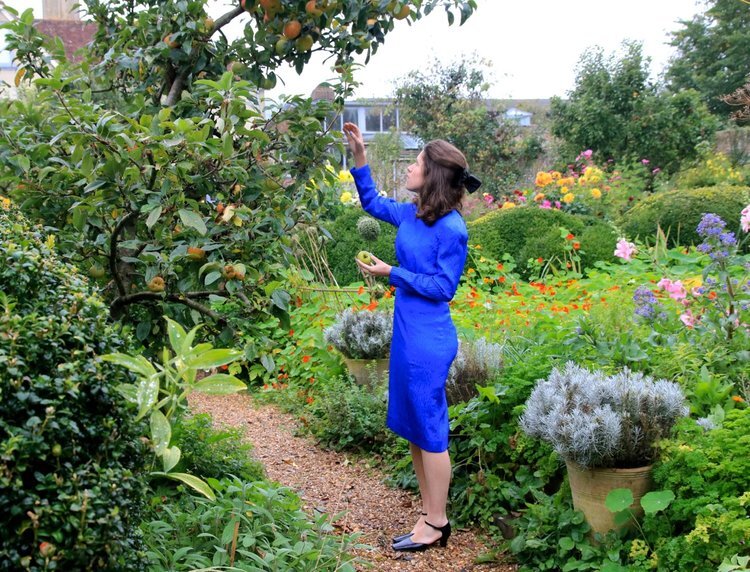I have been wanting to see Painting the Modern Garden: Monet to Matisse for a while and finally got to go last week. Sarah and I chose a Thursday evening - The Royal Academy is open late - and it was definitely a good choice, not too crowded.I really enjoyed this exhibition - it's quite easy going, we agreed that you can stroll through and take in as much or as little as you want, there is not that over bearing pressure to 'learn' something. You just get to enjoy an hour or so of paintings of gardens and flowers.They start you off with the Impressionists - there is a lovely painting by Monet 'The Artist's Garden in Argenteuil (A corner of the garden with Dahlias)'which is really charming. Next are 'international' gardens i.e. not France but painted around the same time. I did like P.S Kroyer's 'Roses' very very much, although I wasn't so keen on the impressionist Max Liebermann's paintings - a bit too much paint. Some of John Singer Sargent's gardens are there, and I am going to admit, having subsequently read the very good catalogue of the exhibition I am unsure if his 'Carnation, Lily, Lily, Rose' is actually in the exhibition. It is in the catalogue and it lives at the Tate Britain if it is not in the exhibition, and I am so pleased to have discovered it.The exhibition then becomes really very exciting - the next room is full of Monet's paintings of his water garden at Giverny with lilies and that Japanese bridge. I love these, and I love that he painted the same view at different times of the day, and different times of the year, so you get to see his garden in all sorts of guises - sometimes pinky orange, other times green, purple and blue. It is wonderful to be able to admire these paintings next to each other. And you get a real feel for the love and dedication Monet had for his garden. It was his absolute pride and joy, so carefully put together and tended too - once he had become a famous artist he had multiple gardeners, and when war broke out he resolutely stayed with his garden, carefully tending to it. And he painted it, many, many times - I love this combination - not only did he create his garden, he also spent his life recording it in paint.The room after gives you an idea of Monet as gardener. It was an exciting time for gardening with new plants being 'discovered', and being brought back from far flung places using Dr. Nathaniel Bagshaw Ward's 'Wardian Case', with hybridisation taking place for the first time. There was the move from very formal gardens (Paris had had formal gardens installed when Hausmann had 'renovated' the city between 1853 and 1870) to the 'wild garden' advocated by William Robinson. The catalogue has an excellent chapter called 'Making the Modern Garden' by Clare A.P. Willsdon which is a fascinating insight into the development of modern garden design and the introduction of plants and flowers. Irises, chrysanthemums, dahlias, peonies and roses were all the rage - although roses were a bit of a pain for the garden designers, as there wasn't a blue variation. These artists really did create their gardens as works of art, all very carefully thought through - and there is much correspondence between Monet and other artists including Van Gogh.Next up are the 'Gardens of Silence', gardens devoid of human life - and I had never heard of many of these artists. There were some incredibly beautiful paintings - Santiago Rusinol's 'Glorieta VII, Aranjuez' , a formal garden bathed in the warmest sunlight which is so serene and a little melancholic. Henri Le Sidaner's 'Steps at Gerberoy' - the garden and house covered in frost or maybe light snow with the windows lit up from inside with a warm glow - it is such a peaceful scene with a tinge of sadness. I enjoyed this this room, I think it is the one I could happily have spent most time in, taking in the calm and sometimes ghostly gardens.And then the 'Avant-Gardeners' - there is a Kandinsky (a garden he tells us) I love Kandinsky a lot, there is an apple tree by Munch, and a lovely little palm tree by Raoul Dufy although I wasn't taken by Emil Nolde's paintings (again, too much caking on of the paint). It was such a joy to see these abstract gardens in their bright contrasting colours by Fauves and German Expressionists arranged together.There is a lot more to see in this exhibition - there are some fun, greatly enlarged black and white photos of artists in their gardens - which rather made me wonder if we will ever live life in the way these artists did - a much slower pace, with few distractions - entirely consumed with growing their gardens and painting their paintings.And there are Monet's willow trees - painted in the last years of his life at Giverny which are so beautiful, and a little wistful. The two willow tree paintings may have been my favourite all.It is a lovely exhibition, do go and see it. I may go back and have a wander amongst the gardens and flowers, so many of them now long forgotten, but with so much meaning to the person both growing and painting them at the time.I bought a very nice postcard of Munch's 'Apple Tree in the Garden' - which is now on my postcard wall. I am creating a postcard wall (very slowly), it is rather nice.Alice xxx




